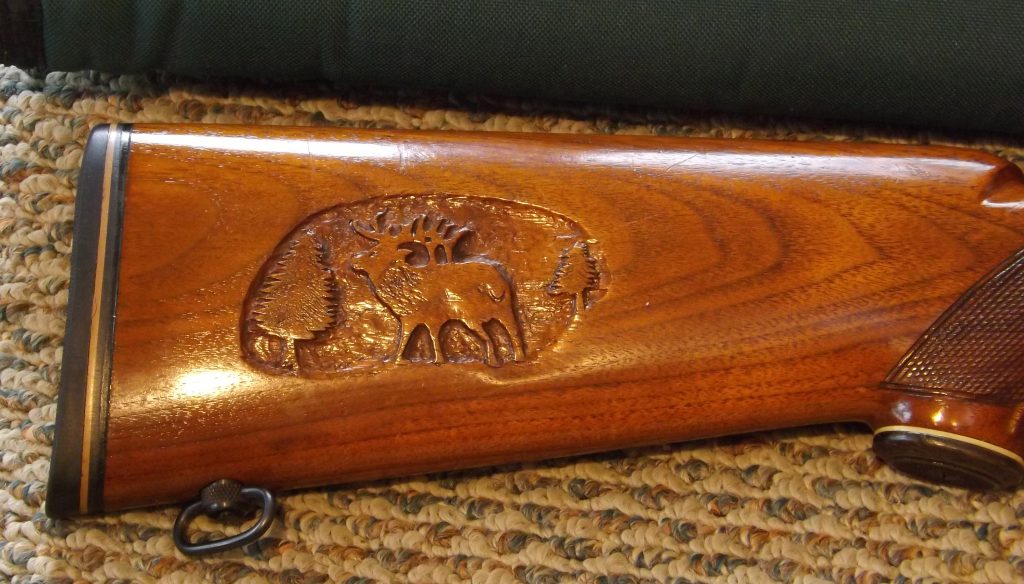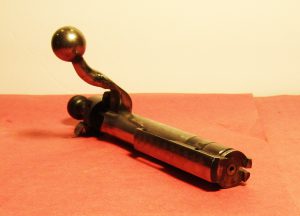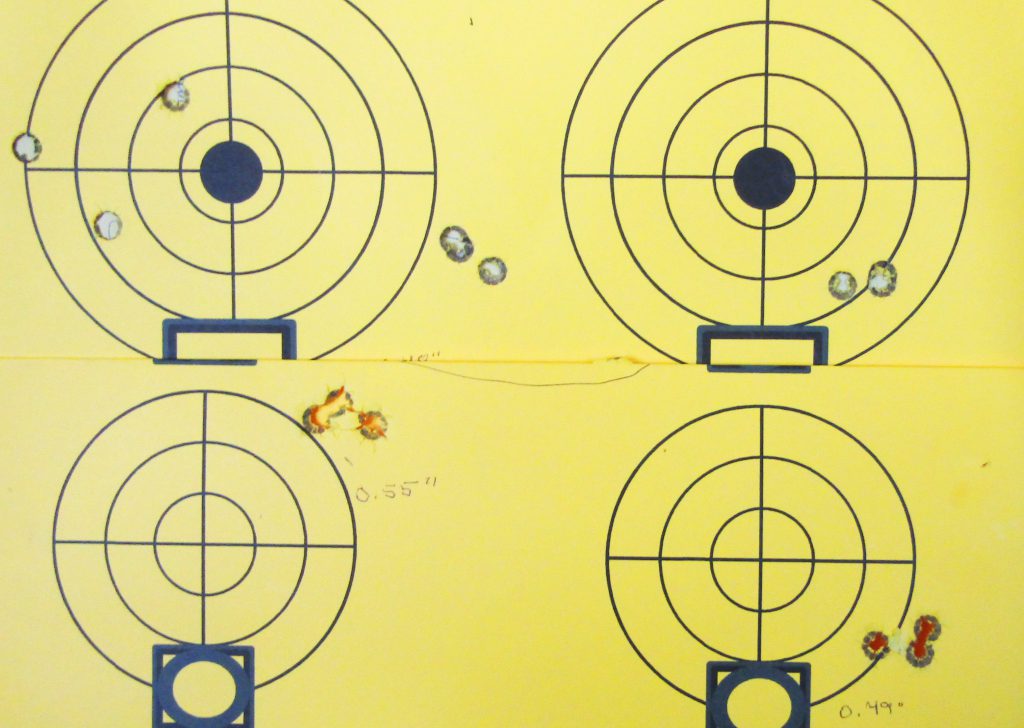This post describes the design, function, and performance of a Savage Model 1920, the first bolt action, sporting rifle offered by a major arms company.
I got me a Savage Nineteen-Twenty
‘Cause old bolt actions I want a-plenty,
I love to see how they work and shoot,
And this one didn’t take much loot,
Collector value was diminished
By a Bubba scope base and wood refinished,
And this one had a further knock,
Some Folk Art Genius CARVED AN ELK IN THE STOCK!
And, it’s really not bad. Unfortunately, the seller, a gunshop in Pennsylvania, could provide no information on the gun, leaving me to imagine a provenance. I think it is a family gun and the person it passed to said “Wow! Grandpa’s rifle. I know he hunted elk with it. I’m gonna FIX ‘ER UP!” Yes, elk have long been hunted in Pennsylvania and the state still issues 125 tags per year. Many are filled. Eventually the elk rifle passed to someone who did not know Grandpa, and then it was traded on a Glock or an AR16. Lucky for me, and the rifle, because I know and appreciate what it is. It will be cared for.
The Savage Model 1920
was the first bolt action sporting rifle to be offered to the hunting public by a major arms company. Yup, the first! The end of World War I had occurred just a couple of years earlier. WWI was fought by infantrymen armed with bolt action rifles, mainly 1903 Springfields and 1917 Enfields for the allies and 1898 and other Mausers for the opposition. Following the war, many sportsmen and makers of sporting equipment felt that demand for bolt action rifles for sporting use would increase. Thus, a good bolt action could compete with traditional lever action rifles of the Winchester pattern for use in the hunting fields. They were right.
At the time, surplus military bolt action rifles were already being used for hunting. Indeed, Krag-Jorgensen (.30-40) rifles had been sold to the public and often “sporterized” for hunting since the early 1900s. Springfield Model 1903 rifles and Mauser 1898 rifles were also available and enterprising gunsmiths could turn them into more appropriate hunting rifles by shortening barrels, decreasing weight, putting on nicer wood, and perhaps rebarreling to another caliber. Naturally, sporting arms manufacturers saw that it would be profitable to offer a bolt action that could come out of the box and head straight for the woods. Savage Arms was the first company to accomplish this in 1920. It was offered for two forward looking Savage cartridges, the .250 Savage (aka .250-3000) and .300 Savage, a new cartridge design that Savage hoped would compete with 150-gr loads in the .30-06 Springfield.
A Photo of the Savage 1920
reveals a very slender rifle. The thin, 24-inch barrel is cradled in a slim forearm that quickly tapers to a Schnabel tip. The walnut stock is checkered (average) in the usual
places and carries a grip cap and butt plate with white line spacers. The spacers are not original and neither is the butt plate which is a plastic replacement of the steel original. Also not original is the unfortunate Bubba scope base, a one-piece Weaver type held by two screws in the receiver ring and one in the receiver bridge.
A closeup of the receiver shows this scope base and also the standard rear sight. This elevated rear notch with the blade front was the only sight system supplied with the 1920 and the receiver was not drilled or tapped for scope bases. A later improvement (1926) of the model provided an aperture sight at the rear. Further examination of this pic shows that the bolt handle rests in a notch in the receiver bridge. Also in evidence is an inexpert attempt by a previous owner to engine turn the bolt, and some grinding on the bolt handle to get scope clearance. This could have been avoided simply by using high scope rings. A lot of amateur rifle tinkerers simply don’t know how to avoid the dumb things they end up doing.
So, why am I wasting your time, you ask? Well, things are going to get better when we take a look at the action in the next picture. It shows that the design is grounded in Mauser practice, but not entirely. The bolt has the dual, opposed front locking lugs and
nonrotating claw extractor so loved by us Mauser mousies, but things are different at the rear. The receiver bridge, which is short to begin with, is notched to hold the bolt handle and has a channel to allow the bolt to be drawn back on opening. The bolt notch is good because it acts as a safety stop. Unlike late Mausers, the Savage bolt has no safety lug. In the bridge in front of the bolt is a notch to allow for stripper clip loading. The part of the bridge that actually spans the action is therefore narrow and the action overall, very short. The receiver ring is short, the bridge is short, the bolt is short, all together, very short. It’s funny that the very first bolt action sporter is of a length so popular with modern shooters that they even want their magnums to be shorties. But it makes sense, thinking that prior to 1920 most rifles in the deer woods were Winchester, Marlin, and Savage lever actions, all noted for being light, quick handlers. Hunters love to compare rifles so a light, quick bolt action rifle would be best able to make inroads in the market. The common military actions were heavy by comparison.
Note also the little round cutout in the rear of the receiver ring at the edge of the ejection port. This gives a little more room for the ejection of the empty, in this case a .300 Savage hull, already one of the shortest thirty caliber rifle cases. This action is positively not a hair longer than necessary to handle this short cartridge.
Continuing, we see another difference with the Mauser is the recoil lug that is sandwiched between barrel and action. It is equipped to take the front guard screw to anchor the action to the wood at that point. The receiver does not ride on rails but is perfectly round. A sheet metal box holds the steel cartridge follower that is conventionally moved by a W-spring. The trigger is a two-stage military type and the tang has a thumb operated sliding safety, a good feature. Under the tang ahead of the safety is a vertical stud that supports the safety spring and guides the bar that blocks the sear and locks the bolt when the safety is on. It all works well.
The safety guide stud is threaded for an action screw. The action needs to be anchored by a screw at the rear, but the safety mechanism prevents that. The stud, however, points at a place in the trigger guard where a screw cannot be placed. What did they do? The screw goes through stock wood above the guard and holds the stud and action down at the rear of the stock. A bit unusual but it works. Two additional screws go through the guard plate, a steel stamping, into escutcheons in the stock. There is also a wood screw behind the trigger loop and an action screw at the front that connects to the recoil lug.
Let’s see, have I covered all of the screws? NO, by golly, there is another small one through the middle of the forearm that connects to a screw socket dovetailed into the bottom of the barrel. Somewhat like Winchester Model 54s as far as position goes. This midbarrel connection is found in a number of old rifles and it always raises a question about its effect on accuracy if changing weather should cause a change in the wood. And its use precludes floating the barrel. No matter, I am keeping it because that is the way it was made in 1920. Well-seasoned wood that has the barrel channel sealed does not change much, anyway, and I never will take it out in the rain.
Shooting the Savage Model 1920
Some folks might question the safety of firing an ancient rifle with modern, factory ammunition and especially with robust handloads. I point out that the rifle was made for smokeless powder and has the Mauser bolt design, always praised for its strength. All makers of .300 Savage ammo follow SAAMI guidelines that specify 46,000 Copper Units of Pressure (CUP). Note that SAAMI specifies 52,000 CUP for the .308 Winchester. At the lower pressure the Remington CorLokt .300 Sav150-gr bullet still gets spit out at 2630 fps advertised velocity. Of course, you must determine prior to shooting that your old rifle is in a condition that allows firing it safely.
Otherwise, the little beauty is light and easy to carry. It comes up quickly to shoulder and cheek with your eye smack on the sight axis. The later Savage Model 40 Super Sporter and still later Savage 340 feel awkward in comparison (yes, I have compared them). The 1920 would be very good for woods carry and snap shooting.
Adding a scope, however, disturbs this happy situation. It adds weight and the stock comb, being good for the open sights, is too low for scope use. Obviously, in 1920, it was not made to use a scope. Nevertheless, since Bubba put a scope base on and it seemed pretty solid, I attached a scope and shot from a bench rest so that a good accuracy evaluation could be had. I used high Weaver rings to hold an old Simmons ProHunter 3-9X that was not doing other work at the time. For initial evaluation I fired three-shot groups at 50 yards with three different factory 150-gr loads.
Velocity Average (Ave), Extreme Spread (ES), Standard Deviation (SD),
Remington 150 grain Core Lokt: Ave 2545 fps; ES 118 fps; SD 31 fps
Federal Power Shok 150 grain: Ave 2575 fps; ES 45 fps; SD 14 fps
Hornady Superformance 150 grain SP: Ave 2676 fps; ES92 fps; SD 26 fps
The velocity results are about as expected considering an advertised velocity of 2630 fps for the standard loads. The Hornady Superformance .300 Savage is unheralded in the shooting press. I tested this ammo and wrote about it some time ago (https://ataleoftwothirties.com/?s=rebirth+300+savage) and others may also have written something about it but I have never seen anything. So many more exciting cartridges to write about, no? I am just happy that Hornady offers this load for the caliber, because it delivers on its claim of offering increased velocity, as do the other rounds in Hornady’s Superformance and LeverEvolution lines. Let’s keep in mind that the Savage does this in a case only 1.87 inches long at a maximum pressure of 46,000 CUP. No, I am not disappointed in the velocities that Mr. Elk Butt achieves.
Accuracy
I was also not disappointed in the accuracy displayed by this old kicker. In truth, based on my thorough preshooting examination, I expected it to shoot pretty well. Everything worked, the bedding was fine, and the bore condition very good. Some groups fired with the factory loads (3 shots at 50 yds) are:
Remington 150-grain: 0.63”, 0.70”, 0.62”
Federal 150-grain: 1.32”, 0.66”
Hornady Superformance 150 gr: 0.48”, 0.55”, 0.49”, 0.41”
The Remington results were very good, but the Hornady Superformance took high honors with four groups, fired consecutively on the same day, that averaged less than 1 MOA. I have to show you the picture. I had no right to expect these results but there they are.
Sure, they are only three-shot groups, but twelve shots with no sign of a flier. I’ll take it, and I will look forward to trying some handloads soon.
Final Thoughts
So, I got me a Savage nineteen-twenty. Too bad it has been molested but the action is original and good enough to illustrate what it was like to handle and shoot the first sporting bolt action. That is what I am interested in, design, function, and performance. In those terms it seems that the first bolt action sporting rifle was a nearly perfect carry rifle for medium game.
And, I have grown very fond of Mr. Elk-Butt.






